
The Oriole Park at Camden Yards is a baseball stadium located in Baltimore, Maryland. It is the home field of Major League Baseball's Baltimore Orioles, and the first of the "retro" major league ballparks constructed during the 1990s and early 2000s. It was completed in 1992 to replace Memorial Stadium.
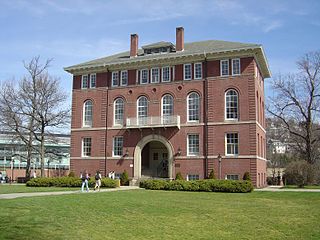
Joseph Evans Sperry (1854–1930) was an American architect, noted for designing buildings in Baltimore. He was born in Georgetown, South Carolina and later relocated to Baltimore, Maryland, where he partnered with James Bosley Noel Wyatt to form the architectural firm Wyatt and Sperry. Their affiliation lasted from 1878 to 1887. The two probably became acquainted while working in the office of Architect, E. Francis Baldwin, where he worked from 1872 until 1876. With Wyatt, he designed a number of buildings around Baltimore before breaking off on his own. Sperry became one of Baltimore's leading architects, designing many public buildings, including churches, hospitals, and banks. In 1914 he was named a Fellow of the American Institute of Architects. Sperry also designed several buildings at Johns Hopkins University and one building at West Virginia University. Sperry's most famous building is probably the Emerson "Bromo-Seltzer" Tower in Baltimore. Sperry's buildings were designed in a variety of styles, but overall were eclectic. Sperry practiced architecture independently from 1888 until he died in 1930.

Bolton Hill is a neighborhood in Baltimore, Maryland, with 20 blocks of mostly preserved buildings from the late 19th century. It is listed on the National Register of Historic Places, preserved as a Baltimore City Historic District, and included within the boundaries of Baltimore National Heritage Area. The neighborhood is bounded by North Avenue, Mount Royal Avenue, Cathedral Street, Dolphin Street, and Eutaw Place. Bolton Hill is a largely residential neighborhood with three-story row houses with red brick, white marble steps, and high ceilings. There are also larger more ornate originally single-family houses, many houses of worship, parks, monuments, and a few large apartment buildings. Many significant residents have lived in the neighborhood, including F. Scott Fitzgerald, Woodrow Wilson, the Cone sisters, and Florence Rena Sabin.

The B&O Warehouse is a building in Baltimore, Maryland, adjacent to Oriole Park at Camden Yards. It was constructed by the Baltimore and Ohio Railroad (B&O) beginning in 1899, with later sections completed in 1905, adjacent to the B&O's Camden Station and Freight Yard, which was located at the corner of Camden St and Eutaw St.

Baltimore Light RailLink is a light rail system serving Baltimore, Maryland, United States, as well as its surrounding suburbs. It is operated by the Maryland Transit Administration. In downtown Baltimore, it uses city streets. Outside the central portions of the city, the line is built on private rights-of-way, mostly from the defunct Northern Central Railway, Baltimore and Annapolis Railroad and Washington, Baltimore and Annapolis Electric Railway. In 2021, the system had a ridership of 2,718,100, or about 9,900 per weekday as of the second quarter of 2022.
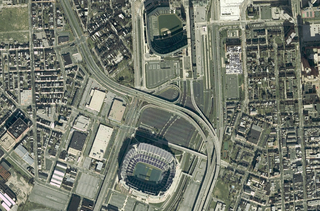
The Camden Yards Sports Complex is located in the center of Baltimore, Maryland. The complex is composed of multiple buildings and stadiums including Oriole Park at Camden Yards and M&T Bank Stadium. The two stadiums are home to the Baltimore Orioles of Major League Baseball and the Baltimore Ravens of the National Football League. The complex still houses the recently closed Sports Legends Museum at Camden Yards. Along with the Sports Legends Museum, the Babe Ruth Birthplace and Museum is located approximately two blocks from the main entrance of Camden Yards at Eutaw Street. Geppi's Entertainment Museum is also located in Camden Station, atop the Sports Legends at Camden Yards. In addition to the sports facilities, it is also a location for community events such as the Dew Tour's Panasonic Open in June 2007 and 2008, the Baltimore Marathon, and the African American Festival which is held every year.

Bromo-Seltzer was a brand of antacid formulated to relieve pain occurring together with heartburn, upset stomach, or acid indigestion. It originally contained sodium bromide and acetanilide, both toxic substances which were eventually removed. Its final formulation contained the pain reliever acetaminophen and two reactive chemicals—sodium bicarbonate and citric acid—which created effervescence when mixed with water. Sodium bicarbonate is an antacid.

The Emerson Tower is a 15-story, 88 m (289 ft) clock tower erected in 1907–1911 at 21 South Eutaw Street, at the northeast corner of Eutaw and West Lombard Streets in downtown Baltimore, Maryland. It was the tallest building in the city from 1911 to 1923, until supplanted by the Citizens National Bank building at the southeast corner of Light and Redwood (German) Streets. It was designed by local architect Joseph Evans Sperry (1854-1930) for Isaac Edward Emerson (1859-1931), who invented the Bromo-Seltzer headache remedy.
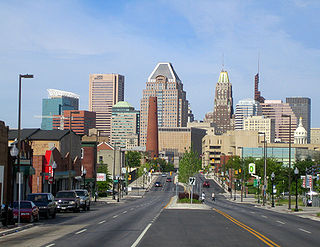
Downtown Baltimore is the central business district of the city of Baltimore traditionally bounded by Martin Luther King, Jr. Boulevard to the west, Franklin Street to the north, President Street to the east and the Inner Harbor area to the south.
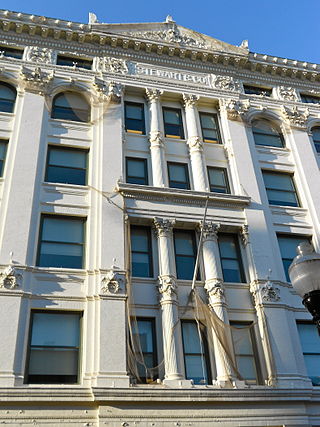
Howard Street is a major north-south street through the central part of the city of Baltimore, Maryland. About 2+1⁄2 miles (4 km) long, the street begins at the north end of I-395 near Oriole Park at Camden Yards and ends near Johns Hopkins University, where it splits. To the right, it becomes Art Museum Drive, the one-block home of the Baltimore Museum of Art. To the left, it becomes San Martin Drive, which winds road along the western perimeter of the Johns Hopkins University campus and ends at University Parkway. Howard Street is named in honor of former Maryland governor John Eager Howard. Two other streets in Baltimore, John and Eager Streets, are also named after him.

Camden Station, now also referred to as Camden Street Station, Camden Yards, and formally as the Transportation Center at Camden Yards, is a train station at the intersection of South Howard and West Camden Streets in Baltimore, Maryland, and is adjacent to Oriole Park at Camden Yards. It is served by MARC commuter rail service and local Light Rail trains. Camden Street Station was originally built beginning in 1856, continuing until 1865, by the Baltimore and Ohio Railroad as its main passenger terminal and early offices/ headquarters in Baltimore and is one of the longest continuously-operated terminals in the United States. Its upstairs offices were the workplace of famous Civil War era B&O President John Work Garrett (1820–1884). The station and its environs were also the site of several infamous civil strife actions of the 19th century with the Baltimore riot of 1861, on April 18–19, also known as the Pratt Street Riots and later labor strife in the Great Railroad Strike of 1877.

One Calvert Plaza, formerly the Continental Trust Company Building, is a historic 16-story, 76 m (249 ft) skyscraper in Baltimore, Maryland. The Beaux-Arts, early modern office building was constructed with steel structural members clad with terra cotta fireproofing and tile-arch floors. Its namesake was chartered in 1898 and instrumental in merging several Baltimore light and gas companies into one citywide system. It was constructed in 1900–1901 to designs prepared by D.H. Burnham and Company of Chicago and is a survivor of the Great Baltimore Fire of February 1904, that destroyed more than 100 acres (40 ha) in the present downtown financial district. When it was built in 1901, it was then the tallest building in Baltimore, and it kept that title until being surpassed by the iconic Bromo-Seltzer Tower of the Emerson Drug Company on the northeast corner of West Lombard and South Eutaw Streets on the downtown west side. Led by Capt. Isaac Edward Emerson, (1859–1931), the inventor of the stomach remedy and antacid, "Bromo-Seltzer" in 1911.
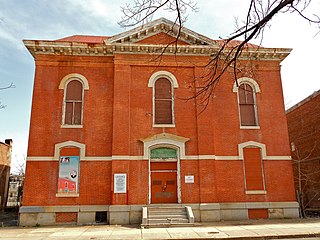
Old West Baltimore Historic District is a national historic district in Baltimore, Maryland, United States. It is primarily a row house neighborhood of approximately 175 city blocks directly northwest of downtown Baltimore. The district includes other housing from grand mansions to alley houses, as well as churches, public buildings, commercial buildings, and landscaped squares. Pennsylvania Avenue, the main street of the community, features a later 20th century municipal market house. Within the district are civic monuments that relate to Baltimore's premier historic African-American community. Such noteworthy figures as Supreme Court Justice Thurgood Marshall, Congressman Parren Mitchell, jazz artist Cab Calloway, civil rights leader Lillie Mae Carroll Jackson, and Carl Murphy, editor of the Baltimore Afro-American newspaper, lived and / or worked in the area.

Charles Center is a large-scale urban redevelopment project in central Baltimore's downtown business district of the late 1950s and early 1960s. Beginning in 1954, a group called the "Committee for Downtown" promoted a master plan for arresting the commercial decline of central Baltimore. In 1955, the "Greater Baltimore Committee", headed by banker and developer James W. Rouse, joined the effort. A plan was developed by noted American urban planner and architect David A. Wallace, (1917−2004), strongly supported by Mayors Thomas L. J. D'Alesandro, Jr. (1947−1959) and Theodore R. McKeldin, and many in their administrations, which formed the basis of a $25 million bond issue voted on by the citizens of Baltimore City during the municipal elections in November 1958. The architects' view of the overall Charles Center Redevelopment Plan with the conceptions of possible buildings, lay-out and plan that was publicized to the voters that spring and summer before, only slightly resembles the actual buildings and designs that later were really constructed by the mid-1970s.

Baltimore is the most populous city in the U.S. state of Maryland, fourth most populous city in the Mid-Atlantic, and the 30th most populous city in the United States with a population of 585,708 in 2020. Baltimore was designated an independent city by the Constitution of Maryland in 1851, and today is the most populous independent city in the United States. As of 2021, the population of the Baltimore metropolitan area was estimated to be 2,838,327, making it the 20th largest metropolitan area in the country. Baltimore is located about 40 miles (64 km) north northeast of Washington, D.C., making it a principal city in the Washington–Baltimore combined statistical area (CSA), the third-largest CSA in the nation, with a 2021 estimated population of 9,946,526.

Captain Isaac Edward Emerson (1859–1931) was a wealthy American businessman, socialite, and seaman. He is most notable for having created the headache remedy Bromo-Seltzer upon which his great wealth was based and the reason he was known as the "Bromo-Seltzer King".
Bromo Arts District is one of four designated arts district in Baltimore, MD and is centered around the Emerson Bromo-Seltzer Tower, which houses artist studios. The district is roughly bounded by Park Avenue on the east, Lombard Street on the south, Paca Street on the west and Martin Luther King Jr. Boulevard and Read Street on the north and is adjacent to the neighborhoods of Mount Vernon and downtown Baltimore. It is home to the University of Maryland Medical Center, Lexington Market, Westminster Hall and Edgar Allan Poe's gravesite, the former Martick's Restaurant Francais and many cultural institutions including the Hippodrome Theatre, the Everyman Theatre, and the Eubie Blake National Jazz and Cultural Center. It is also home to A.T. Jones and Sons, the oldest costume company in the United States.

Stadium Area is a neighborhood in south Baltimore, Maryland. The area is largely consistent of adjacent sports stadiums, M&T Bank Stadium and Oriole Park at Camden Yards, and the surrounding infrastructure supporting them.




























